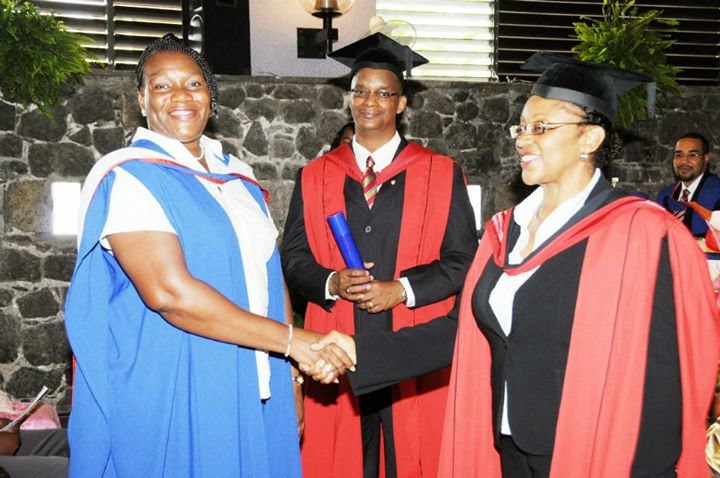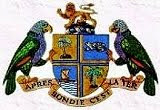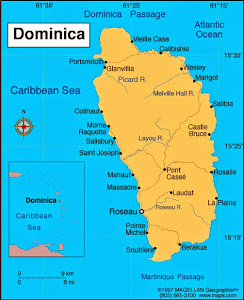
Blessed is the one who finds wisdom, and the one who gets understanding, for the gain from her is better than gain from silver and her profit better than gold. She is more precious than jewels, and nothing you desire can compare with her. Long life is in her right hand; in her left hand are riches and honor. Her ways are ways of pleasantness, and all her paths are peace. She is a tree of life to those who lay hold of her; those who hold her fast are called blessed.(Proverbs 3: 13-18)
DIVINE CARNATION

- Education For All
- I am creative, outgoing and love nature. I am at the top of it all and I know who got me there. My daily Prayer to the Most High God is-- "Oh that Thou wouldest bless me indeed, and enlarge my coast, and that Thine hand might be with me, and that Thou wouldest keep me from evil, that it may not grieve me!"
Search This Blog
Translate
Welcome
The island, which was originally occupied by Carib Indians(some of whose descendants remain), was discovered by Columbus in 1493 and colonised by the French in the 1600s. In 1805, the island became a British possession and remained under British rule until 1967, when internal self-government was granted, followed by full independence in1978.
The Capital of The Commonwealth of Dominica is Roseau. The official language of Dominica is English. A French patois Creole is spoken by most persons on the island.
The Commonwealth of Dominica became an independent state on November 3rd 1978.
The flag of The Commonwealth of Dominica is
 Green, with a centered cross of three equal bands - the vertical part is yellow (hoist side),black, and white and the horizontal part isyellow (top), black, and white; superimposed in the center of the cross is a red disk bearing aSisserou parrot encircled by 10 green, five-pointed stars edged in yellow; the 10 stars represent the 10 administrative divisions (parishes).
Green, with a centered cross of three equal bands - the vertical part is yellow (hoist side),black, and white and the horizontal part isyellow (top), black, and white; superimposed in the center of the cross is a red disk bearing aSisserou parrot encircled by 10 green, five-pointed stars edged in yellow; the 10 stars represent the 10 administrative divisions (parishes).
Dominica Coat of Arms

The shield is supported by two Sisserou parrots (Amazona imperialis). They are perched on a strip of parchment on which is written in Creole, the national motto: "Apres Bondie C’est La Ter". In the established form accepted by Creole linguists today it would be written: "Apwe Bondye Se La Te." It means, "After God it is the Land". However "La Te" can be translated to mean, the land, the Earth or the soil. But the message of the motto for the people of a mainly agricultural island is that after praising God first, the next most important thing is the land in the form of bearing fruit. It can also be extended to mean the land in the nationalist sense that after your commitment to God then comes your commitment to your country. The use of Creole represents also the influence of France on the island and the part played by African traditions and language in the creation of the Creole heritage.
Dominica

Nature Island
Wikipedia
Labels
The best gift to give your child
Educational Resources
Sunday, March 27, 2011
Tips on Implementation jigsaw in the classroom
Most teachers find jigsaw easy to learn
Most teachers enjoy working with it
It can be used with other teaching strategies
It works even if only used for an hour per day
It is free for the taking
Too good to be true? Well, yes and no. It would be misleading to suggest that the jigsaw sessions always go smoothly. Occasionally, a dominant student will talk too much or try to control the group. How can we prevent that? Some students are poor readers or slow thinkers and have trouble creating a good report for their group. How can we help them? At the other end of the talent continuum, some students are so gifted that they get bored working with slower students. Is the jigsaw technique effective with them? In some cases, students may never have experienced cooperative learning before. Will the jigsaw technique work with older students who have been trained to compete with one another? All of these problems are real but not fatal.
The Problem of the Dominant Student
Many jigsaw teachers find it useful to appoint one of the students to be the discussion leader for each session, on a rotating basis. It is the leader's job to call on students in a fair manner and try to spread participation evenly. In addition, students quickly realize that the group runs more effectively if each student is allowed to present her or his material before question and comments are taken. Thus, the self interest of the group eventually reduces the problem of dominance.
The Problem of the Slow Student
Teachers must make sure that students with poor study skills do not present an inferior report to the jigsaw group. If this were to happen, the jigsaw experience might backfire (the situation would be akin to the untalented baseball player dropping a routine fly ball with the bases loaded, earning the wrath of teammates). To deal with this problem, the jigsaw technique relies on "expert" groups. Before presenting a report to their jigsaw groups, each student enters an expert group consisting of other students who have prepared a report on the same topic. In the expert group, students have a chance to discuss their report and modify it based on the suggestions of other members of their expert group. This system works very well. In the early stages, teachers may want to monitor the expert groups carefully, just to make sure that each student ends with an accurate report to bring to her or his jigsaw group. Most teachers find that once the expert groups get the hang of it, close monitoring becomes unnecessary.
The Problem of Bright Students Becoming Bored
Boredom can be a problem in any classroom, regardless of the learning technique being used. Research suggests, however, that there is less boredom in jigsaw classrooms than in traditional classrooms. Youngsters in jigsaw classes report liking school better, and this is true for the bright students as well as the slower students. After all, being in the position of a teacher can be an exciting change of pace for all students. If bright students are encouraged to develop the mind set of "teacher," the learning experience can be transformed from a boring task into an exciting challenge. Not only does such a challenge produce psychological benefits, but the learning is frequently more thorough.
The Problem of Students Who Have Been Trained to Compete
Research suggests that jigsaw has its strongest effect if introduced in elementary school. When children have been exposed to jigsaw in their early years, little more than a "booster shot" (one hour per day) of jigsaw in middle school and high school is required to maintain the benefits of cooperative learning. But what if jigsaw has not been used in elementary school? Admittedly, it is an uphill battle to introduce cooperative learning to 16-year olds who have never before experienced it. Old habits are not easy to break. But they can be broken, and it is never too late to begin. Experience has shown that although it generally takes a bit longer, most high school students participating in jigsaw for the first time display a remarkable ability to benefit from the cooperative structure.
In Conclusion
Some teachers may feel that they have already tried a cooperative learning approach because they have occasionally placed their students in small groups, instructing them to cooperate. Yet cooperative learning requires more than seating youngsters around a table and telling them to share, work together, and be nice to one another. Such loose, unstructured situations do not contain the crucial elements and safeguards that make the jigsaw and other structured cooperative strategies work so well.
The Jigsaw Classroom
Here is how it works: The students in a history class, for example, are divided into small groups of five or six students each. Suppose their task is to learn about World War II. In one jigsaw group, Sara is responsible for researching Hitler's rise to power in pre-war Germany. Another member of the group, Steven, is assigned to cover concentration camps; Pedro is assigned Britain's role in the war; Melody is to research the contribution of the Soviet Union; Tyrone will handle Japan's entry into the war; Clara will read about the development of the atom bomb.
Eventually each student will come back to her or his jigsaw group and will try to present a well-organized report to the group. The situation is specifically structured so that the only access any member has to the other five assignments is by listening closely to the report of the person reciting. Thus, if Tyrone doesn't like Pedro, or if he thinks Sara is a nerd and tunes her out or makes fun of her, he cannot possibly do well on the test that follows.
To increase the chances that each report will be accurate, the students doing the research do not immediately take it back to their jigsaw group. Instead, they meet first with students who have the identical assignment (one from each jigsaw group). For example, students assigned to the atom bomb topic meet as a team of specialists, gathering information, becoming experts on their topic, and rehearsing their presentations. We call this the "expert" group. It is particularly useful for students who might have initial difficulty learning or organizing their part of the assignment, for it allows them to hear and rehearse with other "experts."
Once each presenter is up to speed, the jigsaw groups reconvene in their initial heterogeneous configuration. The atom bomb expert in each group teaches the other group members about the development of the atom bomb. Each student in each group educates the whole group about her or his specialty. Students are then tested on what they have learned about World War II from their fellow group member.
What is the benefit of the jigsaw classroom? First and foremost, it is a remarkably efficient way to learn the material. But even more important, the jigsaw process encourages listening, engagement, and empathy by giving each member of the group an essential part to play in the academic activity. Group members must work together as a team to accomplish a common goal; each person depends on all the others. No student can succeed completely unless everyone works well together as a team. This "cooperation by design" facilitates interaction among all students in the class, leading them to value each other as contributors to their common task.
Individualized Instruction
Individualized instruction is not the same as a one-to-one student/teacher ratio or one-to-one tutoring, as it may seem, because economically, it is difficult, if not impossible to have a teacher for each student. Even the most expensive public school system in the United States (Washington, DC, 2003, approximately $11,000 per student per year) would require at least 5 students per teacher to pay teacher salaries, without anything left for buildings or non-teaching staff.
In a traditional classroom environment, lectures consume approximately 80% of an average teacher's in-class time, to say nothing of the time needed to prepare lessons. Yet lecturing is an inherently inefficient method of conveying information. The average student retains only approximately 10% of what is presented in a lecture, but without substantial reinforcement that figure falls to an abysmal 2%, or less, within 24 hours.
Therefore, throughout the history of education the notion of lecturing has been challenged as a time-effective method of teaching, and alternative pedagogical models have been proposed. For example Educational Research Associates has concluded that placing greater reliance upon well-designed instructional materials – whether audio, video, multimedia Computer-assisted instruction (CAI), or simply a good textbook – can hardly be less efficient than the lecture method, but yields a huge net benefit by freeing teachers to focus upon the needs and problems of individual students.
In this way, individualized instruction is like direct instruction, which also places greater reliance upon carefully prepared instructional materials and explicitly prepared instructional sequences. But where direct instruction is very rigidly structured for use with children in primary school, individualized instruction is recommended only for students of at least junior high school age, and presumes that they have greater self-discipline to be able to study more independently. Thus, individualized instruction has points of contact with the constructivism movement in education, started by Swiss biologist Jean Piaget, which states that the student should build his or her learning and knowledge. Individualized Instruction, however, presumes that most students of secondary school age still lack the basic knowledge and skills to direct most of their own curriculum, which must be at least partially directed by schools and teachers.
In a traditional classroom setting, time (in the form of classes, quarters, semesters, school years, etc.) is a constant, and achievement (in the form of grades and student comprehension) is a variable.
In a properly Individualized setting, where students study and progress more independently, achievement becomes more uniform and time to achieve that level of achievement is more variable.
Where implemented according to Educational Research Associates' recommendations, Individualized Instruction has been found to improve student accomplishment substantially even while reducing cost dramatically.
The coming of computer- and Internet-based education holds the promise of an enormous increase in the use of individualized instruction methodology.
Active Learning
Students who actively engage with the material are more likely to recall information later and be able to use that information in different contexts. However, adopting active learning does not mean eliminating the lecture format. Activities that encourage student involvement are incorporated into the teaching plan. Example activities include: class discussion, small group discussion, debate, posing questions to the class, short written exercises and polling the class.
Active learning is often associated with project-based learning, team-based learning and group cooperative learning, all of them forms of teaching and learning that accommodate and promote collaboration among students to solve problems. This ensures that students really understand the concepts being covered. Team learning is especially beneficial in that ‘weaker’ students are presented with the material from a source other than the professor (i.e. their partner/group mates) and ‘stronger’ students reinforce their knowledge by explaining the material to others.